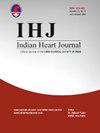Drug-coated balloon in patients with in-stent restenosis: A prospective observational study
IF 1.8
Q3 CARDIAC & CARDIOVASCULAR SYSTEMS
引用次数: 0
Abstract
Aim
The aim of this study was to compare the safety and efficacy of paclitaxel-coated balloons (PCB) and sirolimus-coated balloons (SCB) in patients with in-stent restenosis (ISR).
Methods
This prospective, observational, single-centre pilot study enrolled 85 patients diagnosed with drug-eluting stent ISR. For all the eligible patients, various clinical baseline characteristics were collected, and angiography was performed to evaluate the lesion characteristics. After assessment, patients were treated with either PCB or SCB based on our center's time-based approach. Intravascular ultrasound (IVUS) imagining was used to assess the pre- and post-procedural minimal stent area (MSA). All the patients were followed up and major adverse cardiovascular events were documented for patients in both the groups.
Results
Of total 85 patients with ISR, 32 underwent treatment with PCB and 53 with SCB. A significant difference was noted in the post procedural MSA in both the groups (p = 0.005) and the values were 7.01 ± 1.11 mm2 and 8.01 ± 1.70 mm2 for PCB and SCB group, respectively. At median follow-up of 3.8 years, no cardiac death was noted in PCB group and one death was reported in SCB group (p = 0.459). In PCB group, target lesion revascularization (TLR) was noted in one (12.5 %) patient, while in SCB group TLR was noted in four (16.5 %) patients (p = 0.920).
Conclusion
Both PCB and SCB are found to be effective and safe in treating in patients with drug-eluting stents-ISR. Also, the use of DCB with imaging techniques like IVUS enhances treatment outcomes and optimizes patient care in ISR treatment.
药物包被球囊治疗支架内再狭窄:一项前瞻性观察研究。
目的:本研究的目的是比较紫杉醇包被球囊(PCB)和西罗莫司包被球囊(SCB)在ISR患者中的安全性和有效性。方法:这项前瞻性、观察性、单中心试点研究纳入了85例诊断为药物洗脱支架内再狭窄(ISR)的患者。对于所有符合条件的患者,收集各种临床基线特征,并进行血管造影以评估病变特征。评估后,根据我们中心基于时间的方法对患者进行PCB或SCB治疗。血管内超声(IVUS)成像用于评估术前和术后最小支架面积(MSA)。所有患者均进行了随访,记录了两组患者的主要不良心血管事件。结果:85例ISR患者中,32例接受了PCB治疗,53例接受了SCB治疗。两组术后MSA差异有统计学意义(p=0.005), PCB组和SCB组术后MSA分别为7.01±1.11 mm2和8.01±1.70 mm2。中位随访3.8年,PCB组无心脏性死亡,SCB组1例死亡(P=0.459)。PCB组有1例(12.5%)出现靶病变血运重建术(TLR), SCB组有4例(16.5%)出现TLR (P=0.920)。结论:PCB和SCB治疗药物洗脱支架- isr均安全有效。此外,将DCB与IVUS等成像技术结合使用可以提高治疗效果,并优化ISR治疗中的患者护理。
本文章由计算机程序翻译,如有差异,请以英文原文为准。
求助全文
约1分钟内获得全文
求助全文
来源期刊

Indian heart journal
CARDIAC & CARDIOVASCULAR SYSTEMS-
CiteScore
2.60
自引率
6.70%
发文量
82
审稿时长
52 days
期刊介绍:
Indian Heart Journal (IHJ) is the official peer-reviewed open access journal of Cardiological Society of India and accepts articles for publication from across the globe. The journal aims to promote high quality research and serve as a platform for dissemination of scientific information in cardiology with particular focus on South Asia. The journal aims to publish cutting edge research in the field of clinical as well as non-clinical cardiology - including cardiovascular medicine and surgery. Some of the topics covered are Heart Failure, Coronary Artery Disease, Hypertension, Interventional Cardiology, Cardiac Surgery, Valvular Heart Disease, Pulmonary Hypertension and Infective Endocarditis. IHJ open access invites original research articles, research briefs, perspective, case reports, case vignette, cardiovascular images, cardiovascular graphics, research letters, correspondence, reader forum, and interesting photographs, for publication. IHJ open access also publishes theme-based special issues and abstracts of papers presented at the annual conference of the Cardiological Society of India.
 求助内容:
求助内容: 应助结果提醒方式:
应助结果提醒方式:


